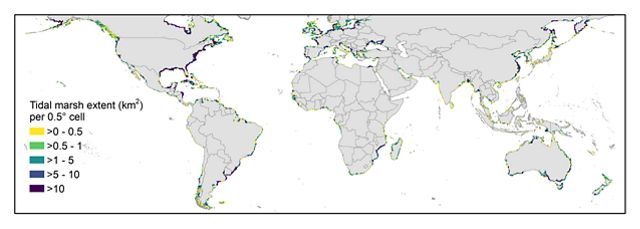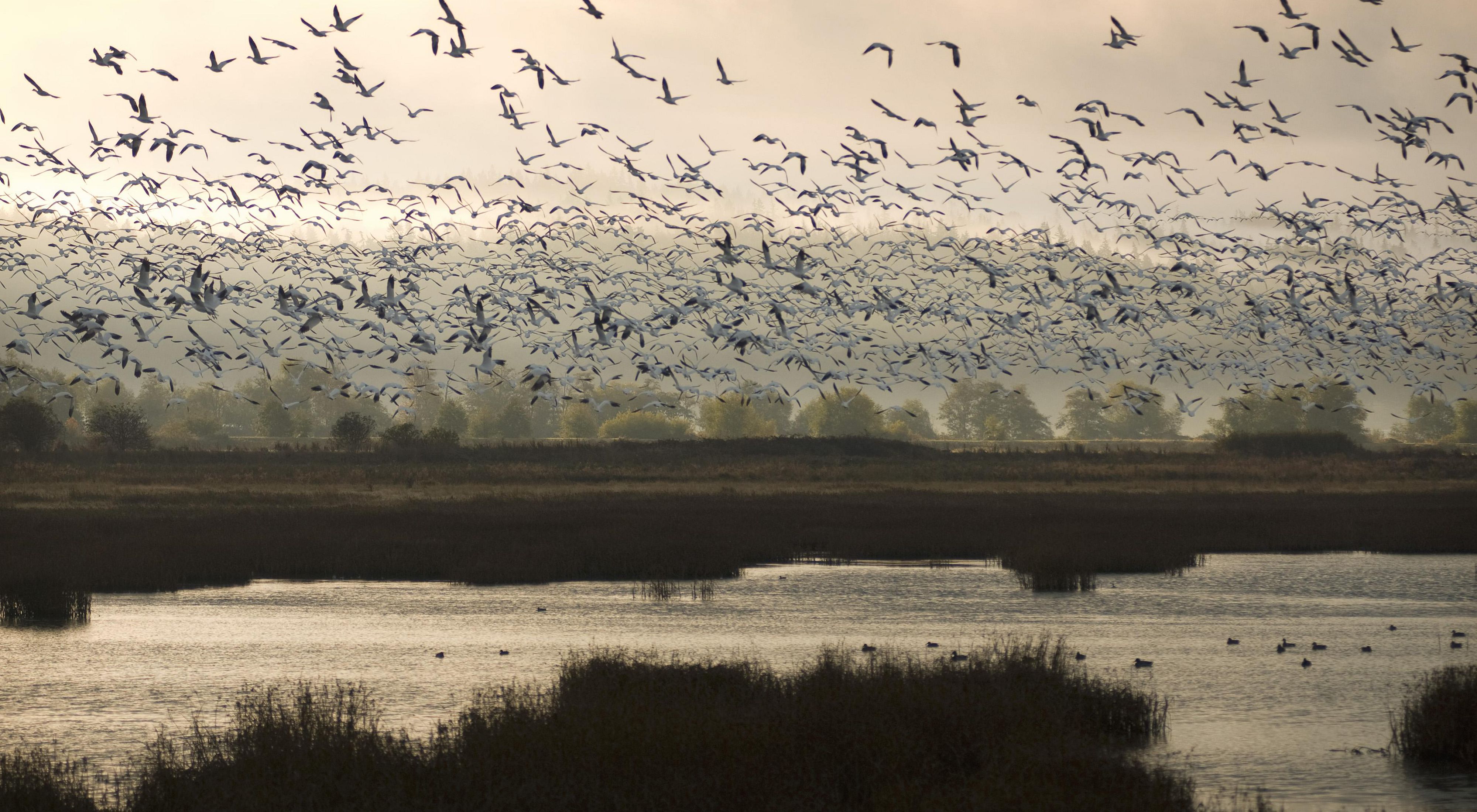The World’s Tidal Marshes Are Finally on the Map
The Nature Conservancy and the University of Cambridge publish first-ever comprehensive map of Earth’s tidal marshes, call for increased restoration
Media Contacts
-
Claire Griffin
Media Relations Coordinator
Email: claire.griffin@tnc.org

In a breakthrough for ecosystem mapping, researchers at The University of Cambridge and global environment nonprofit The Nature Conservancy (TNC) have published the first globally consistent map of Earth’s tidal marshes.
The 10m resolution map is now publicly available on Google Earth Engine App. These often underappreciated yet highly productive coastal ecosystems are critical contributors to human wellbeing, climate, and biodiversity. The map will allow countries to better understand the extent of tidal marsh habitat along their shores, and to identify opportunities for conservation and restoration.
Tidal marshes – which include both salt and freshwater marshes – are supercharged ‘blue carbon’ ecosystems found across cool, temperate and some tropical regions that play a similar ecological role to that of mangroves. The marshes store carbon in their soils for millennia, making them crucial contributors to climate change mitigation efforts. They also support countless plant species in their nutrient-rich soils and represent vital ‘nursery’ environments, as well as feeding and nesting grounds for billions of birds, fish, molluscs and crustaceans.
“Until now, small-scale maps have depicted the local extent of tidal marshes, but there has been no globally consistent map” said co-author Mark Spalding, Senior Marine Scientist at TNC and part of the Conservation Science Laboratory in the University of Cambridge. “The new map shows areas we’ve known about for a long time, such as the extensive tidal marshes in the Chesapeake Bay, USA, but now we can also see their distribution in places where they are often overlooked—including the Middle East, North Africa and South America.”
The global map highlights the Atlantic shores of North America and Northern Europe as the global epicentre, home to 45% of the world’s tidal marshes. Their location on rich, low-lying land adjacent to waterways (often some of the world’s most populated areas) means tidal marshes have long been cleared and drained for agriculture, industry, transport networks and urban expansion. So much tidal marsh area has been degraded or drained, in fact, that these ecosystems are now rare – covering only 53,000 km2 of land across the globe (that's less than the size of West Virginia, about a quarter of the area of Great Britain). In comparison, mangroves cover nearly three times the area. As with mangroves, however, tidal marshes are considered a blue carbon ecosystem par excellence and protecting what remains is critical.
“We know the value of tidal marshes at a local level,” said Judy Haner, Director of Marine Programs at The Nature Conservancy of Alabama, which oversees the landmark Lightning Point restoration project along one of the state’s most iconic shorelines. “The Lightning Point project – which effectively created new tidal marsh habitat from scratch in a degraded estuary heavily reliant on its seafood economy – has during its short lifetime increased community resiliency and protected this iconic fishing community from multiple major storms. We are also seeing nesting shorebirds return to the coast, in marshes that simply did not exist just a few years ago.”
The researchers behind the new tidal marsh map hope that local conservation initiatives like Lightning Point can provide powerful blueprints, while the global map can encourage a vast scaling up of conservation, enabling communities the world over to benefit from tidal marsh conservation and restoration.
Maps produced in 2010 for the world’s mangroves led to an explosion in research around mangroves, led by TNC and many other institutions, and contributing ultimately to the creation of Global Mangrove Watch. This powerful platform uses remote sensing data to give real-time insights into the extent and health of the world’s mangroves, allowing policymakers and practitioners to make better-informed decisions regarding the conservation and management of these special places.
Elaborating further on the project’s rationale, Dr Tom Worthington, a TNC-funded researcher at the University of Cambridge and senior author of the research, adds: “The publication of this map is provoking a similar upsurge of interest in the conservation of tidal marshes, and should focus attention, especially in areas where these ecosystems have historically been overlooked. The map also gives researchers a baseline against which to measure future changes to these ecosystems, allowing countries to build more effective tidal marsh protection and restoration into their national climate mitigation and adaptation strategies.”
The Nature Conservancy and partners at the University of Cambridge and the University of Delft are already working on several associated initiatives, including a global model of carbon storage in tidal marshes that will be applied to the existing map, as well as a global model of the importance of tidal marshes in protecting people and infrastructure from storm surges and flooding. Projects like these will further improve the world’s understanding of tidal marshes in the global carbon cycle and provide more information of the risks from further loss—bringing these critical ecosystems into wider conversations about climate mitigation.
“It is only with global maps like this one that we can really see the big picture,” Spalding concludes. “It starts with the map, but real progress and impact will come from the further research, informed decisions and practical actions the map enables and catalyses.”
###
Note: the associated academic paper is undergoing review. In the interim, a public pre-release can be viewed here and cited as follows:
Worthington, T. A., M. Spalding, E. Landis, T. L. Maxwell, A. Navarro, L. S. Smart, and N. J. Murray. 2023. The distribution of global tidal marshes from earth observation data. bioRxiv DOI: 10.1101/2023.05.26.542433
For research inquiries, please contact mark.spalding@tnc.org.
The Nature Conservancy is a global conservation organization dedicated to conserving the lands and waters on which all life depends. Guided by science, we create innovative, on-the-ground solutions to our world’s toughest challenges so that nature and people can thrive together. We are tackling climate change, conserving lands, waters and oceans at an unprecedented scale, providing food and water sustainably and helping make cities more sustainable. The Nature Conservancy is working to make a lasting difference around the world in 81 countries and territories (40 by direct conservation impact and 41 through partners) through a collaborative approach that engages local communities, governments, the private sector, and other partners. To learn more, visit nature.org or follow @nature_press on X.
